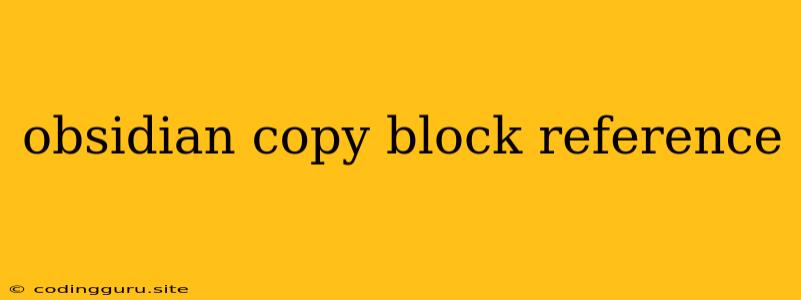Master the Art of Note-Taking with Obsidian's Copy Block Reference
Obsidian, the powerful and versatile note-taking application, provides a plethora of features that help streamline your workflow and boost your productivity. One such feature, the Copy Block Reference, is a game-changer for anyone who wants to link and reference information seamlessly within their notes.
What is a Copy Block Reference?
Imagine you're writing a research paper, a creative story, or even just a to-do list. You have several notes that contain relevant information, and you want to bring snippets of them into your current note without manually copying and pasting the entire text. This is where the Copy Block Reference comes in.
Instead of copying and pasting entire sections, you can simply create a reference to a specific block of text in another note. This reference will automatically display the content of that block in your current note, allowing you to easily access and incorporate the information you need.
Why Use Copy Block References?
- Streamlined Note-Taking: By using Copy Block References, you avoid redundant information in your notes, reducing clutter and promoting a more organized workflow.
- Dynamic Linking: Unlike simple links, Copy Block References ensure that the referenced content always stays up-to-date. If you edit the original block, the changes will automatically reflect in all the notes where it's referenced.
- Efficient Collaboration: When working with others, Copy Block References make it easier to share specific pieces of information without having to copy and paste the entire note.
- Flexible Integration: Copy Block References can be used in various contexts, from research papers to creative projects, and even for generating to-do lists based on information from other notes.
How to Use Copy Block References
- Select the Block: In the note you want to reference, highlight the block of text you want to include.
- Copy Block Reference: Right-click on the selected block and choose "Copy Block Reference".
- Paste the Reference: Go to the note where you want to include the referenced content and paste the copied reference.
- View the Content: The reference will appear as a block with the original content displayed within it.
Tips for Using Copy Block References Effectively:
- Give Your Blocks Meaningful Names: Use descriptive names for your blocks to make it easier to find them later.
- Organize Your Notes: Structure your notes in a way that makes sense for your workflow and makes it easy to find the information you need.
- Use Backlinks: Leverage the power of backlinks to navigate between related notes quickly and efficiently.
Examples of Using Copy Block References
- Research Paper: You're writing a research paper on the history of artificial intelligence. In your "AI History" note, you have several blocks detailing different milestones. You can create a Copy Block Reference to these blocks in your research paper, seamlessly integrating the relevant information.
- Project Planning: You have a note for each project task. Each task note might contain a block for "Next Steps" or "Resources Needed". You can create a Copy Block Reference to these blocks in a "Project Overview" note, creating a dynamic and up-to-date summary of your project.
Conclusion:
The Copy Block Reference is a powerful and versatile feature that can greatly enhance your note-taking experience. By using it effectively, you can streamline your workflow, increase your productivity, and make your notes more dynamic and informative. Embrace the power of Copy Block References and discover a new level of efficiency in your note-taking process.
